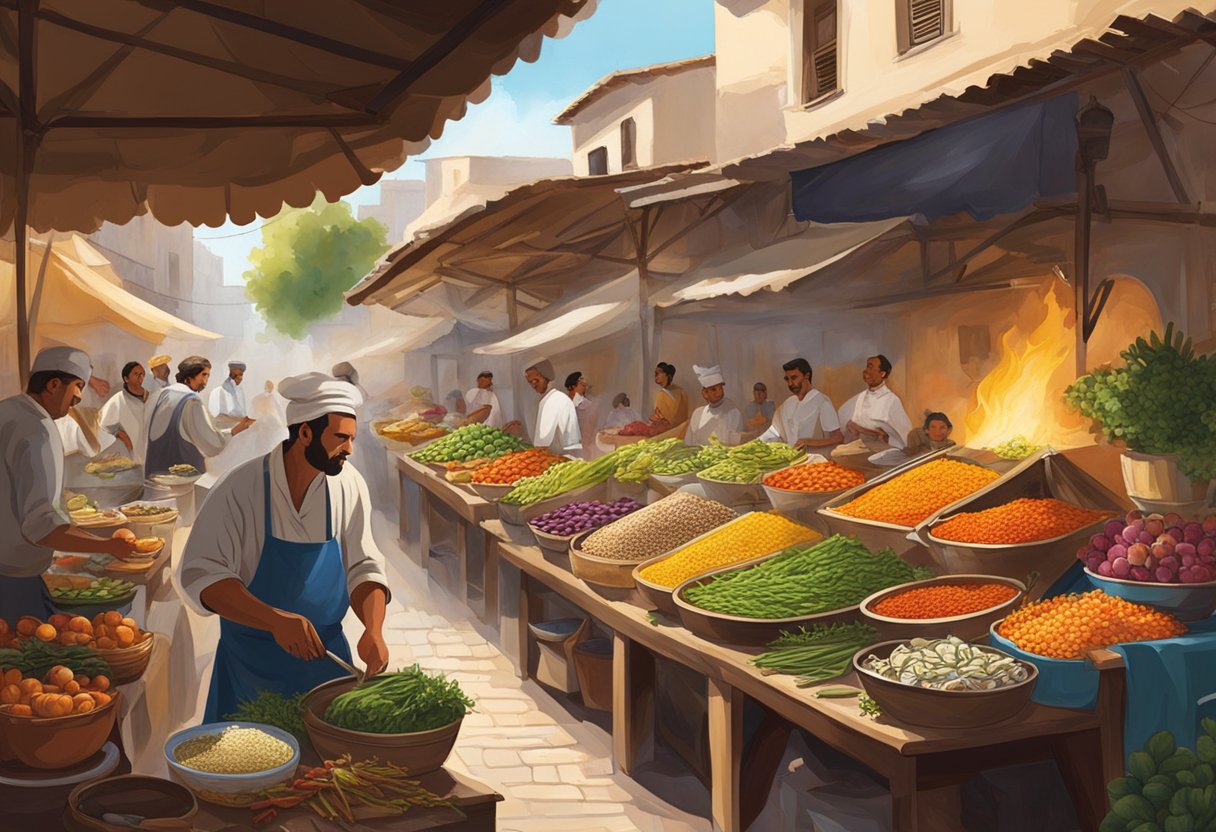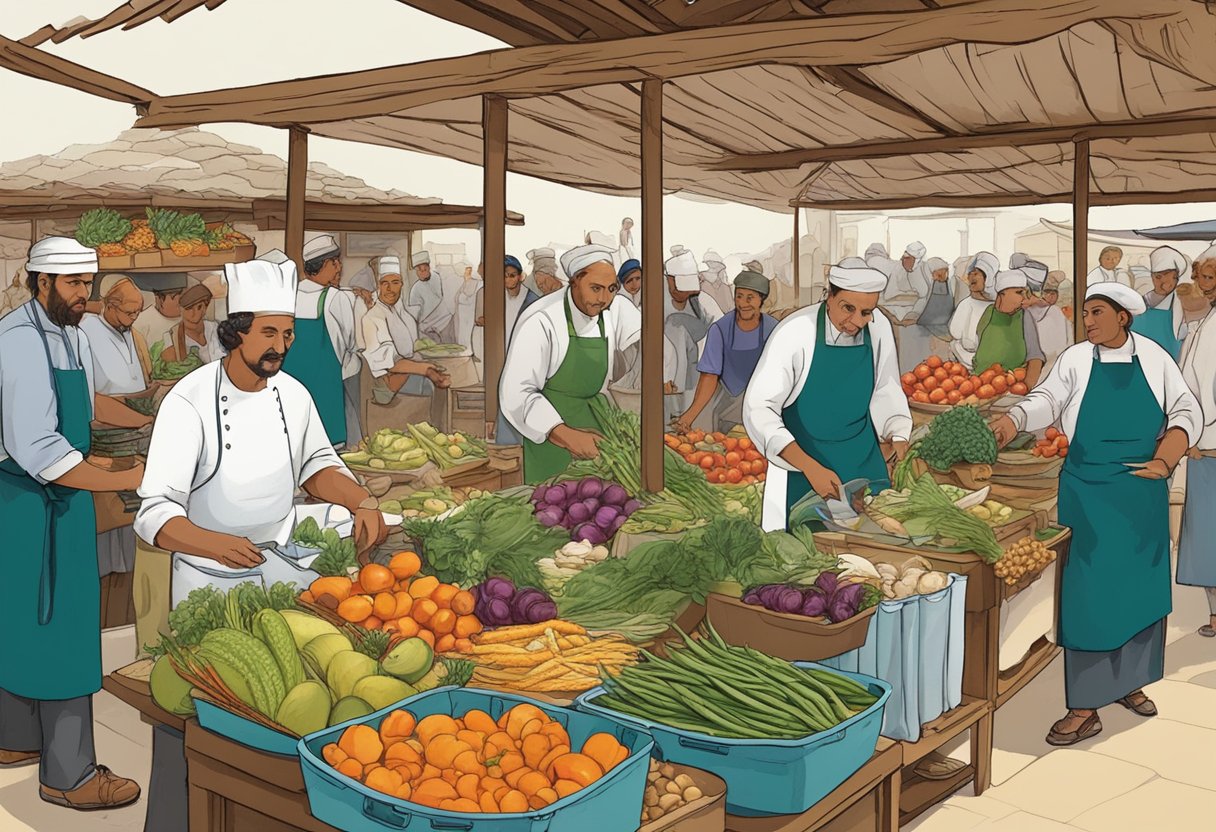Mediterranean cuisine represents a culinary tradition with ancient heritage, regarded for its variety and depth of flavors influenced by numerous cultures. A look at the origins of this cuisine unveils a rich tapestry woven by the eating habits and agricultural practices of civilizations such as the Egyptians, Greeks, and Romans. These civilizations laid the fundamental groundwork that has been cultivated over millennia, contributing to the widespread appreciation of this diverse gastronomic region.

The integration of geography and climate has also played a pivotal role in shaping Mediterranean cuisine. Coastlines along the Mediterranean Sea benefited from ample sunshine and mild weather, fostering the growth of a plethora of ingredients that are central to the diet’s identity today. The cuisine stands out for its emphasis on plant-based foods, hearty grains, lean proteins, and an abundance of fruits and vegetables, all of which cater well to a gluten-free diet.
Cultural exchanges among the peoples of the Mediterranean basin have led to the development of staple dishes and techniques, uniquely tying the region’s heritage and lifestyle to its food. This fusion of tastes and traditions reflects the region’s historical complexity and has profoundly impacted its healthful culinary reputation in today’s global culinary scene.
Key Takeaways
- Mediterranean cuisine is grounded in ancient traditions and influenced by the interplay of diverse cultures.
- Its development is closely linked to the region’s climate and geography, promoting a variety of naturally gluten-free ingredients.
- The diet is synonymous with health and longevity, maintaining cultural significance and adapting to the modern palate.
Table of Contents
Historical Roots of Mediterranean Cuisine

The Mediterranean cuisine, known for its diverse flavors and healthful attributes, has deep roots in history, stretching back to ancient civilizations. This section examines the contributions of these early cultures and the subsequent culinary evolution through cultural exchanges.
Ancient Civilizations Influence
The Greeks and Romans, along with Egypt and the Middle East, laid the foundational stone for Mediterranean cuisine. The Greeks introduced olives and olive oil, a staple in today’s gluten-free Mediterranean diet. In parallel, Roman culinary practices involved an array of foods like fish sauce and wine that remain essential to modern-day Mediterranean cooking. These traditions reflect a commitment to fresh ingredients and simple, naturally gluten-free meals that have withstood the test of time.
Cultural Exchange and Culinary Evolution
Beyond the initial contributions of ancient civilizations, Mediterranean cuisine has been continuously enriched by the strong undercurrents of cultural exchange. The spice trade routes introduced new flavors from the East, which chefs incorporated into traditional dishes, often emphasizing gluten-free grains such as rice and corn that are integral to the current gluten-free Mediterranean diet. Through the ages, as peoples from different regions mingled, this culinary cross-pollination solidified a food culture that both respects its history and evolves by embracing new influences.
Geographic and Climatic Impact

The diverse geography and climate of the Mediterranean region have deeply influenced its cuisine, with each area contributing distinctive ingredients and culinary techniques that adhere to a gluten-free diet.
Southern Europe’s Contributions
Southern Europe, notably Italy, Greece, Spain, and France, has shared its bounty with the Mediterranean through its rich agricultural landscapes and climatic variety. Italy’s sun-soaked hills foster the growth of gluten-free staples like rice and corn, which are central to dishes like risotto and polenta. Greece’s temperate climate allows for the cultivation of olives and grapes, essential for olive oil and wine, which stand as pillars of a gluten-free Mediterranean diet. Spain adds to the gluten-free options with its array of fresh vegetables and fruits, such as tomatoes and oranges, while France’s influence is seen in the use of herbs like thyme and lavender that season dishes without the need for gluten-containing additives.
Africa’s Influence on Mediterranean Cooking
North Africa, with countries like Morocco and Tunisia, brings forth a warm climate that influences its culinary culture with an emphasis on bold flavors and gluten-free grains. The use of sorghum and millet in North African cuisines offers gluten-free alternatives to wheat-based staples. These grains feature prominently in regional specialties such as tajines and couscous, the latter often adapted with gluten-free options like corn or rice couscous.
The Spice Routes of Asia
The ancient spice routes spanning Asia have left a significant mark on Mediterranean cuisine, introducing a spectrum of spices to Mediterranean cookery. Gluten-free spices like turmeric, cumin, and coriander are now integral to the flavor profiles of Mediterranean dishes. These spices not only enhance taste without the need for gluten but also offer various health benefits, aligning with the diet’s focus on wholesome, naturally gluten-free foods.
Key Ingredients of Mediterranean Cuisine
Mediterranean cuisine is characterized by its reliance on a diversity of fresh, wholesome ingredients that form the backbone of its dishes. These components are celebrated for their health benefits and are often used in a manner that supports a gluten-free diet.
Olive Oil: Liquid Gold
Olive oil is more than a mere cooking fat in Mediterranean cooking; it’s an essential element brimming with flavor and nutritional value. Revered for its heart-healthy fats, it’s used extensively in cooking and as a dressing. For those embracing a gluten-free lifestyle, olive oil serves as a safe and versatile alternative to butter and other fats that may contain gluten.
Common olive oil uses:
- Dressing for salads and vegetables
- Cooking base for sauces and sautés
- Dip for gluten-free breads
Fresh Produce and Herbs
The region’s sun-ripened vegetables and fruits, alongside an array of fragrant herbs, stand out in Mediterranean recipes. Leafy greens, tomatoes, cucumbers, and zucchinis are staples, often accompanied by fruits like figs, grapes, and citrus. Herbs such as oregano, basil, and mint add depth to dishes without the need for gluten-containing additives.
Typical produce and herbs:
- Vegetables: bell peppers, eggplants, onions
- Fruits: lemons, oranges, pomegranates
- Herbs: rosemary, thyme, parsley
The Role of Seafood and Meats
Seafood is a principal protein source, with an emphasis on fish like sardines and mackerel that are rich in omega-3 fatty acids. For meat options, grilled poultry and lean cuts of lamb or goat are preferred. While Mediterranean cuisine does incorporate grains, for those on a gluten-free diet, these can be substituted with gluten-free grains such as quinoa or varieties of rice.
Table of Protein Sources in a Gluten-Free Mediterranean Diet:
| Type | Examples |
|---|---|
| Seafood | Tuna, sea bass, shellfish |
| Meats | Chicken, turkey, rabbit |
| Legumes | Lentils, chickpeas, beans |
Bold flavors come from cheeses like feta and halloumi, and nuts such as almonds and pistachios offer crunch and nutrition. Instead of traditional wheat-based bread, gluten-free alternatives made from grains like buckwheat or corn ensure that all can enjoy the full spectrum of Mediterranean flavors without concern for gluten.
Central Dishes and Cooking Techniques

The Mediterranean region is renowned for its diverse and flavorful cuisine, where staples like rice, fish, and olive oil dominate. Here we explore the dishes and methods that exemplify Mediterranean cooking, with an emphasis on gluten-free ingredients.
The Mediterranean Diet Staples
The staples of the Mediterranean diet include inherently gluten-free foods such as:
- Olives and Olive Oil: Central to the diet, olive oil is used extensively in cooking and as a dressing.
- Rice: A substitute for wheat, rice serves as a base for many dishes like paella.
- Tomatoes: Fresh, sun-ripened tomatoes are a key ingredient in sauces and salads.
- Fish: A primary source of protein, fish is often grilled or baked with herbs.
- Fruits and Vegetables: These are consumed in high quantities, providing essential nutrients and fibers.
For those avoiding gluten, staples such as couscous can be replaced with rice, while gluten-rich pasta can be substituted with varieties made from rice or other gluten-free grains.
Art of Mediterranean Cooking
Mediterranean cooking techniques emphasize preserving the natural flavors and nutritional value of ingredients:
- Grilling and Baking: Fish are often grilled or baked to retain moisture and delicate textures.
- Herb Utilization: Fresh herbs, such as mint, parsley, and thyme, are used to enhance flavors without the need for gluten-containing thickeners.
- Stews and Slow Cooking: Techniques like slow cooking allow for the infusion of spices and herbs, creating tender vegetables and meats. Traditional wheat grains in stews can be replaced with gluten-free alternatives like rice.
The mastery of these techniques ensures that even those on a gluten-free diet can enjoy the full spectrum of Mediterranean flavors.
Cultural Significance and Health Aspects
The Mediterranean diet melds age-old culinary traditions with a modern understanding of nutrition, emphasizing not only the role of diet in preventing heart disease but also its importance in cultural exchange. It creates a flavorful melting pot of ingredients and techniques that have evolved over millennia.
Health Benefits of the Mediterranean Diet
The Mediterranean diet offers a plethora of health benefits due to its rich variety of fresh vegetables, legumes, fruits, nuts, and whole grains, which are all staples in a gluten-free regime. Olive oil, a primary source of added fat in the diet, contributes to the reduction of heart disease risk. The diet limits red meat and emphasizes fish and poultry, which are sources of lean protein and omega-3 fatty acids, known for their role in maintaining a healthy heart. This way of eating not only aligns with guidelines for heart disease prevention but also includes naturally gluten-free options that cater to those with gluten sensitivities or celiac disease.
- Key Nutrients: Fruits, vegetables, and nuts provide essential vitamins and minerals.
- Heart Health: Olive oil and fish contribute to a lower risk of heart disease.
- Gluten-Free Focus: Naturally gluten-free grains, such as rice and quinoa, are integral to the diet.
Mediterranean Cuisine as a Cultural Melting Pot
Mediterranean cuisine represents a rich cultural exchange that has occurred over centuries. As a melting pot, different cultures and civilizations have contributed diverse ingredients and flavors to the regional culinary tradition. This cultural tapestry is woven through the food, where each meal is a testament to the region’s history of conquests, commerce, and cooperation. One finds culinary influence from North African spices, Greek simplicity, Italian zest, and Middle Eastern complexities, offering a satisfying experience while respecting the gluten-free dietary needs.
- Cultural Exchange: Spices and cooking methods vary between countries, showing a history of sharing and adaptation.
- Diverse Influences: From Greek to Middle Eastern, regional dishes reflect a tapestry of traditional influences.
- Unity and Variety: Common threads, such as the use of olive oil and fresh produce, unite otherwise diverse cuisines.
Mediterranean Cuisine in the Modern World
Mediterranean cuisine, while anchored in its traditional roots, has evolved significantly due to globalization. It has been adapted in various parts of the world including America, with a notable trend towards maintaining balance and healthfulness, such as the incorporation of gluten-free options.
Global Influences and Adaptations
The cross-continental spread of Mediterranean food is a testimony to its adaptability and global appeal. In America and beyond, chefs and home cooks alike have embraced and tailored Mediterranean dishes, weaving in local ingredients and dietary preferences. Gluten-free adaptations of classics like pasta and bread have become especially popular, catering to a growing demand for inclusive dining options.
One sees a wealth of gluten-free grains such as quinoa and millet being skillfully integrated into salads, pilafs, and side dishes. These grains, while not traditionally Mediterranean, complement the cuisine’s emphasis on fresh vegetables and olive oil, while providing alternatives to wheat and other gluten-containing grains. This culinary syncretism not only enriches the global food scene but also increases the accessibility of Mediterranean cuisine to a wider audience, including those who follow a gluten-free diet.
The Future of Mediterranean Cuisine
Looking ahead, the future of Mediterranean food appears robust and dynamic. As consumer interest in sustainable and balanced diets continues to rise, Mediterranean cuisine—with its focus on plant-based ingredients, olive oil, and lean proteins—is well-positioned to become a cornerstone in the global culinary landscape.
Continued innovations, especially those driven by health and sustainability trends, will likely see the cuisine’s principles of freshness and simplicity being applied to novel ingredients and methods. Trends also hint at an uptick in gluten-free Mediterranean foods gaining prominence on restaurant menus and supermarket shelves, reflecting both an adherence to culinary tradition and a response to the evolving dietary needs and preferences of an increasingly health-conscious consumer base.
Conclusion

The enduring culinary tradition of the Mediterranean region is reflective of its deep-rooted traditions and a testament to the resilience and innovation of its people. The diet is renowned for its diversity, emphasis on fresh produce, and health benefits, adapting naturally to gluten-free preferences without compromising on taste or nutritional value.
The cuisine thrives on a rich palette of gluten-free ingredients:
- Grains: Rice and corn replace traditional wheat.
- Proteins: Legumes, seafood, and lean meats are staples.
- Fats: Olive oil remains the quintessential source of healthy fats.
- Vegetables and Fruits: A cornucopia that provides both nutrients and flavors.
As the Mediterranean culinary tradition progresses, it continues to echo the past while incorporating modern dietary needs. The future of this cuisine looks promising, especially as the world becomes more health-conscious and people seek diets that are not only wholesome but also sustainable and gluten-free.
The region’s cuisine underscores a bond that transcends borders—a common thread that weaves through various cultures and times. It does so while embracing inclusivity and addressing the changing dietary requirements of people around the world. The Mediterranean diet, abundant in naturally gluten-free foods, may become even more central to our understanding of healthy eating.
Its adaptability and inherent variety promise that the Mediterranean diet will remain a dynamic force in the global culinary landscape, continuing to evolve but always staying true to its flavorful and healthful roots.
Frequently Asked Questions

The origins of Mediterranean cuisine are deeply entwined with the region’s history, culture, and geography. Each question in this section addresses the intricate tapestry of influences that have shaped this culinary tradition.
What historical events shaped the Mediterranean culinary landscape?
Historical events, such as the Arab agricultural revolution, contributed to the development of farming techniques and the introduction of new ingredients. The Moorish influence between the 8th and 15th centuries also significantly impacted culinary practices, particularly in Spain.
Which cultures have had the most significant impact on the evolution of Mediterranean food?
Cultures including the Ancient Egyptians, Greeks, Romans, Moors, and Ottomans have each left their mark on Mediterranean cuisine. Their legacies are seen in the use of particular ingredients and cooking methods that are still popular today.
How did geography and climate influence the Mediterranean diet?
The Mediterranean region’s diverse geography and mild climate have promoted a diet rich in fruits, vegetables, cereals, and nuts. The coastal areas’ access to seafood and the inland’s emphasis on olives and wheat have become central elements of the diet.
What are some ancient food staples that are central to Mediterranean dishes?
Staples such as olives, wheat, grapes, and certain legumes have been cornerstones of the diet for millennia. They are frequently used in traditional recipes and are also suitable for those following a gluten-free diet when chosen carefully.
Can you trace the development of Mediterranean cuisine through different historical periods?
It’s possible to trace the development of Mediterranean cuisine from the ancient civilizations through the Middle Ages, the Renaissance, and into modern day. Each period introduced new ingredients and techniques that evolved into the dishes cherished around the world today.
Which book from the 1950s famously described Mediterranean cuisine, and what was its impact?
The book titled “A Book of Mediterranean Food,” published in 1950, famously chronicled Mediterranean cuisine and has significantly influenced the culinary world’s appreciation for this region’s dishes, promoting a diet recognized for its flavors and health benefits.



